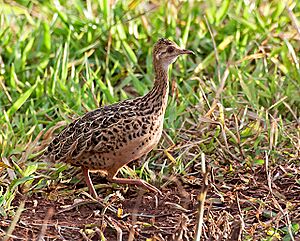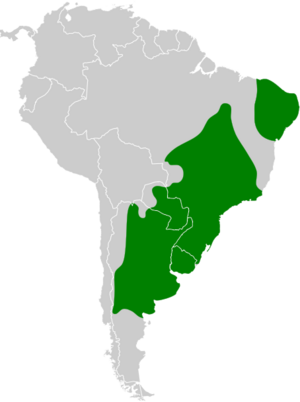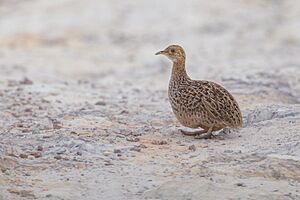Spotted nothura facts for kids
Quick facts for kids Spotted nothura |
|
|---|---|
 |
|
| Conservation status | |
| Scientific classification | |
| Genus: |
Nothura
|
| Species: |
maculosa
|
| Subspecies | |
|
N. m. maculosa |
|
 |
|
The spotted nothura (scientific name: Nothura maculosa) is a special type of bird called a tinamou. You can find this bird living in grassy areas. It lives in eastern and southern Brazil, Paraguay, Uruguay, and parts of Argentina.
Contents
About the Spotted Nothura
The spotted nothura is about 24 to 25.5 centimeters (9.4 to 10 inches) long. Its upper body is brown with buff streaks. The underside is buff with black and brown streaks on its chest. Its sides have a barred pattern.
The top of its head is black with buff streaks. Its throat is white. The bird's color can change a lot depending on where it lives. This is partly because of the different types of soil. The spotted nothura and its close relative, the Chaco nothura, are unique. They are the only nothuras with bars on both sides of their main flight feathers. Their legs are usually dull yellowish-grey or brown.
Spotted Nothura Behavior
The spotted nothura makes a call that sounds like a series of short, high-pitched notes.
What Spotted Nothuras Eat
The spotted nothura eats both plants and animals. They usually eat seeds from plants. They also eat small animal matter. In Argentina, they seem to eat more animal matter than in other places.
Spotted Nothura Reproduction

This bird can have many babies quickly. A female can become ready to lay eggs in just two months. She can have five to six groups of eggs (broods) each year. The male bird takes longer to grow up.
The male nothura is the one who sits on the eggs. He also takes care of the baby chicks. Like most tinamous, their eggs have a beautiful, shiny shell. It looks like porcelain. The eggs are a rich maroon or chocolate brown color. A group of eggs (a clutch) usually has 4 to 6 eggs.
Spotted Nothura Family Tree
All tinamous belong to the family called Tinamidae. They are also part of a larger group of birds called ratites. Other ratites include ostriches and emus. Unlike most ratites, tinamous can fly. However, they are not very strong fliers. All ratites developed from ancient birds that could fly. Tinamous are the closest living relatives to these old flying birds.
Coenraad Jacob Temminck was the first person to identify the spotted nothura. He found a specimen from Paraguay in 1815.
Spotted Nothura Subspecies
There are nine types of spotted nothura that scientists recognize today. These types are called subspecies. They are not very different from each other. They mostly change gradually from north to south. This change follows rules about how animals adapt to their environment.
- N. m. maculosa: Found in southeastern Brazil, northeastern Argentina, eastern Paraguay, and Uruguay.
- N. m. major: Lives in the middle of east central Brazil. This includes the Minas Gerais, Goiás, and Bahia States.
- N. m. nigroguttata: Found on the plains of south central Argentina. This includes Rio Negro and southeastern Neuquén Provinces.
- N. m. cearensis: Lives in northeastern Brazil, specifically southern Ceará State.
- N. m. paludivaga: Found in central Paraguay and north central Argentina.
- N. m. annectens: Lives in the moist grasslands of eastern Argentina.
- N. m. submontana: Found in the Andean foothills of southwestern Argentina. This includes Neuquén, Rio Negro, and Chubut Provinces.
- N. m. pallida: Lives in the moist Chaco grasslands of northwestern Argentina.
- N. m. chacoensis: This is the Chaco nothura. It is found in northwestern Paraguay and north central Argentina.
Where Spotted Nothuras Live
The spotted nothura lives in eastern and southern Brazil. It avoids the Mata Atlântica forest and the high plateaus along the coast. It also lives in Paraguay, Uruguay, and Argentina.
Spotted Nothura Habitat
This bird makes its home in dry savanna areas. It can live up to 2,300 meters (7,500 feet) high. It also lives in temperate grasslands and even in pastures where animals graze.
Spotted Nothura Conservation
The IUCN (International Union for Conservation of Nature) says this tinamou is of Least Concern. This means it is not currently in danger of disappearing. Even though people hunt it a lot, it reproduces very quickly. Its living area covers a huge space of about 3,900,000 square kilometers (1,500,000 square miles).



